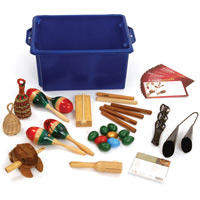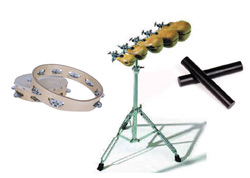Auxiliary Percussion

Auxiliary percussion instruments include things like the triangle, tambourine, and castanets. While these instruments might seem trivial or easy to play, they often have complex parts in the music and are an integral part of a piece of music.
The appearance of a triangle is exactly what it sounds like—a metal triangle suspended from a string. The triangle is hit (tapped) with a small metal beater and produces a very delicate "ding" sound.
There are a number of percussion instruments that are shaken to produce their sound, maracas being the most common. Maracas were originally gourds whose seeds had dried out and would make a noise when shaken. There are now all kinds of containers filled with small seeds, small metal ball bearings, rice, and other loose material. When these instruments are shaken, they all produce a similar sound.
Tambourines can also be shaken; the small metal jingles (like tiny cymbals) rattle in its frame. Claves are two pieces of wood that are hit together and wood blocks, which look exactly as they are named, are hit with a stick to produce short piercing staccato sounds. Guiros are long ribbed tubes. A stick is used to rub across the ribs producing a raspy sound.
Some of these auxiliary instruments make up another family of percussion instruments known as Latin Percussion. These instruments come mainly from the Latin American region, but also have roots in Africa. The most common Latin Percussion instruments include the bongos, congas, cowbell, shaker, guiro, claves, and timbales.
Study the image provided and listen to the sound sample of a Latin Percussion Ensemble to gain an understanding of these instruments.
![]() Listen to the sample of Mongo Santamaria and Tito Puente—Latin Percussion Ensemble:
Listen to the sample of Mongo Santamaria and Tito Puente—Latin Percussion Ensemble:
